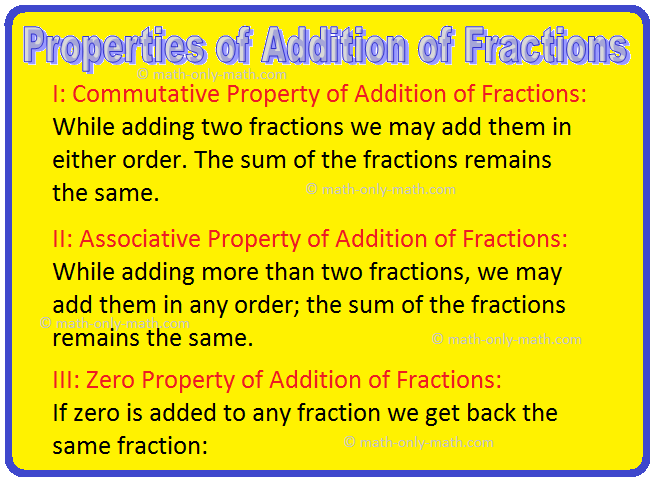Subscribe to our ▶️ YouTube channel 🔴 for the latest videos, updates, and tips.
Properties of Addition of Fractions
The associative and commutative properties of natural numbers hold good in the case of fractions also.
I: Commutative Property of Addition of Fractions:
While adding two fractions we may add them in either order. The sum of the fractions remains the same.
|
Add: \(\frac{2}{3}\) + \(\frac{1}{4}\) L.C.M. of 3, 4 is 12 \(\frac{2}{3}\) + \(\frac{1}{4}\) = \(\frac{8}{12}\) + \(\frac{3}{12}\) = \(\frac{11}{12}\) |
Add: \(\frac{1}{4}\) + \(\frac{2}{3}\) L.C.M. of 4, 3 is 12 \(\frac{1}{4}\) + \(\frac{2}{3}\) = \(\frac{3}{12}\) + \(\frac{8}{12}\) = \(\frac{11}{12}\) |
i.e., \(\frac{2}{3}\) + \(\frac{1}{4}\) = \(\frac{1}{4}\) + \(\frac{2}{3}\)
II: Associative Property of Addition of Fractions:
While adding more than two fractions, we may add them in any order; the sum of the fractions remains the same.
|
Add: [\(\frac{2}{5}\) + \(\frac{3}{4}\)] + \(\frac{1}{3}\) L.C.M. of 5 and 4 is 20. [\(\frac{2}{5}\) + \(\frac{3}{4}\)] + \(\frac{1}{3}\) = [\(\frac{8}{20}\) + \(\frac{15}{20}\)] + \(\frac{1}{3}\) [\(\frac{2}{5}\) + \(\frac{3}{4}\)] + \(\frac{1}{3}\) = \(\frac{23}{20}\) + \(\frac{1}{3}\)
L.C.M. of 20 and 3 is 60. = \(\frac{69}{60}\) + \(\frac{20}{60}\) = \(\frac{89}{60}\) = 1\(\frac{29}{60}\) |
Add: \(\frac{2}{5}\) + [\(\frac{3}{4}\) + \(\frac{1}{3}\)] L.C.M. of 4 and 3 is 12. = \(\frac{2}{5}\) + [\(\frac{9}{12}\) + \(\frac{4}{12}\)] = \(\frac{2}{5}\) + \(\frac{13}{12}\) L.C.M. of 5 and 12 is 60. = \(\frac{24}{60}\) + \(\frac{65}{60}\) = \(\frac{89}{60}\) = 1\(\frac{29}{60}\) |
i.e., [\(\frac{2}{5}\) + \(\frac{3}{4}\)] + \(\frac{1}{3}\) = \(\frac{2}{5}\) + [\(\frac{3}{4}\) + \(\frac{1}{3}\)]
III: Zero Property of Addition of Fractions:
If zero is added to any fraction we get back the same fraction.
|
Add: \(\frac{1}{2}\) + 0 = \(\frac{1}{2}\) + \(\frac{0}{2}\) = \(\frac{1 + 0}{2}\) = \(\frac{1}{2}\) Therefore, \(\frac{1}{2}\) + 0 = 0 + \(\frac{1}{2}\) = \(\frac{1}{2}\) |
Add: \(\frac{5}{6}\) + 0 = \(\frac{5}{6}\) + \(\frac{0}{6}\) = \(\frac{5 + 0}{6}\) = \(\frac{5}{6}\) Therefore, \(\frac{5}{6}\) + 0 = 0 + \(\frac{5}{6}\) = \(\frac{5}{6}\) |
Questions and Answers on Properties of Addition of Fractions:
I. Fill in the Blanks:
(i) \(\frac{3}{5}\) + \(\frac{1}{4}\) = \(\frac{1}{4}\) + ______
(ii) \(\frac{1}{6}\) + ______ = \(\frac{1}{8}\) + ______
(iii) \(\frac{7}{15}\) + \(\frac{3}{5}\) + \(\frac{2}{9}\) = \(\frac{2}{9}\) + ______ + \(\frac{3}{5}\)
(iv) \(\frac{9}{20}\) + \(\frac{4}{15}\) + ______ = \(\frac{3}{5}\) + \(\frac{9}{20}\) + \(\frac{4}{15}\)
Answer:
I. (i) \(\frac{3}{5}\)
(ii) \(\frac{1}{8}\); \(\frac{1}{6}\)
(iii) \(\frac{7}{15}\)
(iv) \(\frac{3}{5}\)
II. Verify the following (show that left hand side = right hand side)
(i) \(\frac{3}{5}\) + \(\frac{2}{8}\) = \(\frac{2}{8}\) + \(\frac{3}{5}\)
(ii) [\(\frac{1}{6}\) + \(\frac{2}{3}\)] + \(\frac{1}{4}\) = \(\frac{1}{6}\) + [\(\frac{2}{3}\) + \(\frac{1}{4}\)]
From Properties of Addition of Fractions to HOME PAGE
Didn't find what you were looking for? Or want to know more information about Math Only Math. Use this Google Search to find what you need.



New! Comments
Have your say about what you just read! Leave me a comment in the box below. Ask a Question or Answer a Question.